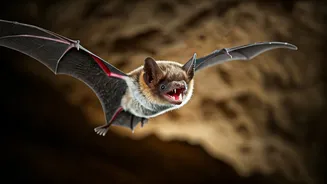Echolocation Masters
Bats possess an extraordinary ability: echolocation. They emit high-pitched sounds that bounce off objects in their environment. By analyzing the echoes,
bats create a detailed 'sound map' of their surroundings, even in complete darkness. This process enables them to navigate, locate prey, and avoid obstacles with incredible precision. They can differentiate between tiny insects and determine their location, size, and even the direction they are flying, all through sound. This incredible natural sonar is far more sophisticated than anything humans have created, showcasing the bats' remarkable sensory adaptations. This ability is crucial for their survival, allowing them to thrive in various habitats worldwide.
Dietary Diversity of Bats
The bat diet is incredibly varied, depending on the species and habitat. Some bats are insectivores, consuming vast quantities of insects each night, acting as natural pest control. Others are frugivores, relying on fruits and playing a vital role in seed dispersal, which is important for the regeneration of forests. There are also nectar-feeding bats, who pollinate flowers, contributing significantly to plant reproduction. A few species are even carnivores, feeding on small animals like frogs, fish, or other bats. This dietary diversity reflects their ecological importance and their adaptation to various food sources.
Bats and Ecosystems
Bats are essential components of ecosystems, performing critical roles. Insectivorous bats control insect populations, protecting crops and reducing the need for pesticides. Frugivorous and nectar-feeding bats help pollinate plants and disperse seeds, supporting plant biodiversity and forest regeneration. Their presence impacts the health of forests and the well-being of the ecosystems they inhabit. The loss of bats could have cascading effects, disrupting ecological balances and potentially leading to declines in plant diversity and increased pest populations, affecting the environment significantly.
Bat Hibernation Secrets
Many bat species undergo a period of hibernation during the colder months. They seek out caves, mines, or other sheltered locations, where they drastically lower their metabolism and body temperature to conserve energy. This allows them to survive through periods when food is scarce. During hibernation, their heart rate slows dramatically, and they become less active. These remarkable adaptations are essential for bats to survive harsh winter conditions. The specific strategies and hibernation duration varies depending on the species and the geographic location.
Threats Facing Bats
Despite their many benefits, bats face numerous threats. Habitat loss due to deforestation, urbanization, and agricultural expansion is a major concern. White-nose syndrome, a fungal disease, has decimated bat populations in North America. Pesticide use and climate change also pose risks. These threats significantly impact bat populations, leading to declines in various species. Conservation efforts are crucial to protect bat habitats, manage disease outbreaks, and promote sustainable practices to ensure the survival of these valuable creatures. Public awareness and conservation actions are essential to safeguard bat populations for future generations.














